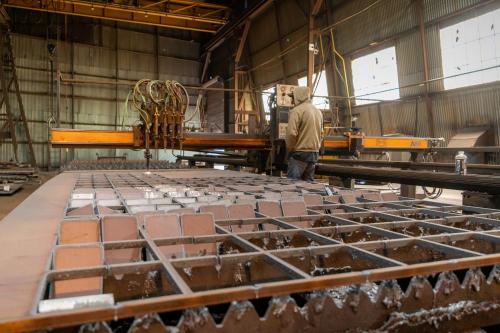Flame cutting, or oxy-fuel cutting, is one of the various methods used to cut metal materials into specific sizes and shapes and is a widely used industrial process for cutting thick steel and other metals.. During this process, oxygen and fuel are combined to create a flame that has the ability to cut through most metals, including steel. The technique employs a mixture of oxygen and a fuel gas (such as acetylene, propane, or natural gas) to create an intensely hot flame, which is directed onto the metal surface. The combination produces what is called a preheat flame, and the temperature of the flame can range somewhere between 4,440° to 6,000° F. Temperatures vary based on the fuel source being used, as well as the amount of oxygen and fuel applied to produce the flame. This form of production is usually used on carbon steel grades, particularly with steel HR plates and sheets.
How Flame Cutting Works
The process of flame cutting can be broken down into a few basic steps:
-
Preheating: A preheat flame, generated by burning a mixture of fuel gas and oxygen, is applied to the metal surface. This flame raises the temperature of the steel to its ignition point, typically around 900°C to 1,100°C (1,650°F to 2,000°F), without melting the material.
-
Oxygen Jet: Once the metal reaches the required temperature, a high-pressure stream of pure oxygen is introduced. This stream reacts with the hot steel, causing rapid oxidation, which generates additional heat and burns through the material.
-
Material Removal: The reaction between the oxygen and the steel forms iron oxide, or slag, which is blown away by the force of the oxygen jet. As the torch is moved along the cutting path, this process continues, effectively cutting through the material.
Applications for Flame Cutting Steel
Flame cutting is most effective for thick steel, typically 1 inch (25 mm) or greater, though it can be used for thinner materials as well. It is often employed in:
- Construction and fabrication: Cutting structural steel, beams, and plates for buildings, bridges, and other large structures.
- Shipbuilding: Shaping large steel plates and sections.
- Heavy equipment manufacturing: Creating components for industrial machines, vehicles, and tools.
- Repair and salvage work: Removing damaged sections of metal and cutting steel scrap for recycling.
Advantages of Flame Cutting
-
Cuts Thick Material: Flame cutting is particularly effective for cutting very thick sections of steel, sometimes exceeding 12 inches (300 mm) in thickness.
-
Cost-Effective: The equipment used for flame cutting is relatively inexpensive compared to alternative cutting methods like laser or plasma cutting.
-
Portability: Oxy-fuel cutting equipment is portable, making it suitable for fieldwork or repair jobs that require mobility.
-
Versatility: It can cut through a wide range of metals, including mild steel, low-alloy steel, and cast iron.
Limitations of Flame Cutting
-
Surface Finish: The process leaves behind a rough edge that may require secondary processing, such as grinding, to smooth out the cut surfaces.
-
Limited to Ferrous Metals: Flame cutting works best on ferrous metals like carbon steel. It is less effective for cutting non-ferrous metals (e.g., aluminum, copper, stainless steel) because these metals do not oxidize in the same way.
-
Heat-Affected Zone (HAZ): The high heat input can cause distortion, warping, or changes in the metal's microstructure. This can affect the strength and performance of the cut steel in certain applications.
-
Slower Cutting Speed: Compared to modern cutting technologies like plasma or laser, flame cutting is slower and may not be suitable for high-volume production of intricate parts.
Applications of Oxy-Fuel Cutting
Most oxy-flame torches are used to cut material ranging from 3/8" up to 12" in thickness. Flame cutting was originally used on all thickness sizes, but the invention of plasma and laser cutting has made flame cutting obsolete for thinner sizes. Nonetheless, due to its economy, most operations still favor the cutting torch vs. the plasma cutter for low alloy steels.
Some other advantages of flame cutting include having a lower operating cost than other cutting methods, having the ability to cut thicker materials than other cutting methods, having the ability to cut through a larger surface area on a given material, and also having the ability to be integrated with CNC technology. CNC integration allows for a precise geometry of required shapes, as well as controlling the speed and output of the fuel and oxygen inputs.
Flame Cut Steel at ECONSTEEL
Visit our Services page to find out more about our specific flame cutting capabilities here at ECONSTEEL, and learn how we can fuel your operation's quality and efficiency.
Flame cutting remains a reliable and cost-effective method for cutting thick steel in various industries. While it may have limitations in terms of cutting speed and precision, its ability to handle large and thick steel sections makes it indispensable in heavy industries like construction and shipbuilding. The technique has been widely adopted for decades and continues to be a valuable tool in steel processing.

